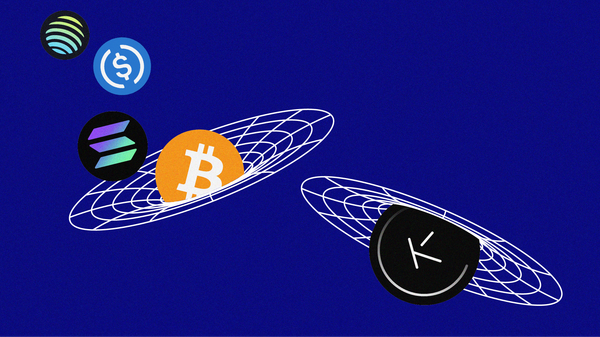Are Altcoins Cooked?
Perhaps buying Bitcoin was the best play after all.

Regardless of continuous favorable price action displayed by majors and the US stock market, confidence in altcoins seems to be at an uncharacteristic low. Expectations instilled by previous cycles have left many disappointed and in a state of disbelief while their portfolio returns stagnate in an uptrend.
The State of Things
Sentiment in the space tends to be fickle and volatile, as people often exaggerate, especially when they’re overexposed. Biases can change on a whim, making sentiment on social media an unreliable indicator for forming an accurate outlook on the market. However, what we can do is plot some relevant data on charts and conduct armchair analysis to determine how grim the situation really is.

Indexes and aggregated charts tracking various global metrics give us a broad overview of the market as a whole, aiding in identifying where most of the value lies and how it has changed.
The total crypto market capitalization has increased notably over the last year and a half with surprisingly little volatility. Although Bitcoin reached a new all-time high, levels witnessed during the 2021 mania have yet to be breached, largely due to altcoins being unable to keep up with the orange coin’s rate of growth. Capital flows to more speculative assets have been less than expected, catching many off guard.
This phenomenon can be better illustrated by directly charting Bitcoin against the altcoin market (excluding Ethereum), showcasing its continuous appreciation.
Needless to say that this time around Bitcoin has stolen the show, distancing itself from the pack by consistently garnering more and more of the market share during its ascent. Essentially leaving altcoins in the dust. What used to be a lucrative game of catch-up between Bitcoin and the rest of the market has now turned into a pipe dream. The absence of liquidity trickling down the ladder has curbed any attempts at initiating a proper market-wide alt season.
In spite of it actively being mocked for its unimpressive price action, Ethereum has also managed to stay ahead of the curve. Speculators positioning themselves in on-chain ecosystem tokens, other than memecoins or anything denominated in stablecoins, have been treated to a delightful stay in purgatory. Our sincerest condolences to those who fell for the ETH beta con.
Indicators widely used to find advantageous conditions for entering or exiting the alt market have been conveying concerning signals, suggesting that commonly held beliefs about market dynamics might not apply to the present situation.
The correlation between major assets and everything else has proven useful in establishing the current state of the market. By incorporating an oscillator (blue line) that tracks the difference between the two among other things, engagement levels can be configured and subsequently used for confluence. Low oscillator values, coupled with a rising Bitcoin price, are usually seen as grounds for buying under the presumption that altcoins are undervalued and will eventually follow suit. Recent readings reveal that bullish periods for altcoins have gradually become briefer and weaker, incentivizing short-term investments over uncertain higher time frame ones.
Many seemingly promising coins have struggled to deliver superior returns despite their higher perceived upside potential.
This is reflected by the underwhelming performance of the Top 250 compared to the two biggest assets, which have been somewhat neglected by many participants in the space due to their astronomical valuations. Further driving down sentiment.
Needles in a Haystack
It’s glaringly obvious that the landscape has changed over time, identifying trends and narratives has become more important than ever in order to beat the index. The days of everything simply going up all at once seems to be over. Liquidity fragmentation and declining volume has concentrated most of the significant gains to a handful of sectors. While general metrics point towards altcoins being in dire straits as a collective with marginal value add, they do, however overshadow the disparate growth of individual asset groups.
Strictly observing the market capitalization change of various baskets since the start of the rally indicates that most established categories, fell below the benchmarks. Emerging areas with an abundance of opportunities, appeal and new developments, on the other hand did incredibly well. It’s worth noting that outliers can exist in any sector and growth within a curated group only vaguely represents the performance of the encompassed assets.
To recap everything that has happened so far and determine who was right and who was wrong, let’s highlight some relevant categories and measure the price returns of their most valuable assets.
Price Return Calculation Methodology
To account for recent launches that have made their way in to the top of their category, the start price is either queried from 21-11-2022 or the first entry on CoinGecko. The current price is queried at the time of this article being written, 18-06-2024.
price_return_% = ((current_price - start_price) / start_price) * 100
Memecoins
Undoubtedly the theme of this cycle. Memecoins in the last year have generated more overnight millionaires than the lottery and simultaneously taking away enough wealth to rival the tax man.
The total valuation of memecoins hasn’t changed percentage-wise as much as one would expect, due to the likes of Dogecoin and Shiba Inu making up nearly half the market share while barely moving an inch upward. Much of the meme activity apart from some wildly successful tokens on Ethereum has taken place on Solana and more recently, Base. The highest returns and new Top 10 entrants (3) originated from Solana with percentages in two instances exceeding five digits.
DeFi
Revenue. Fundamentals. The future of finance. Protocol usage, volume and total value locked metrics are on the rise as more people venture on-chain. Did all this warrant a new expansion? Well, not really.
Innovation and product-market-fit aside, price returns for DeFi (excluding 1.0) coins are nothing short of horrid as every project other than Pendle and The Graph fell flat on their faces. Liquid staking as a market saw massive growth and adoption in the last couple of years, but governance tokens representing the liquid wrappers did not. Tokens related to decentralized exchanges suffered the worst price action out of the bunch, with just Jupiter remaining in the green.
Though the table above sets a worrisome precedent for the field, perhaps the industry’s forefather — DeFi 1.0, managed to defy expectations.
Indiscriminate of their high valuations, earnings and utilization rates, legacy protocols have proven to be a poor investment this cycle unless a yield strategy is employed to offset depreciation. A recurring theme for DeFi protocols, attributing to the lackluster performance, is the absence of use cases for their tokens apart from liquidity mining. Fee switches could be the saving grace, as it creates substantial buy pressure for the token by offering users real yield, not emissions diluting their holdings.
L1s
By far the most popular and frequently traded category among speculators, layer-1 blockchains are the face of the industry and have historically showcased solid price action thanks to Bitcoin and Ethereum leading the charge. Advancements in the area have spawned countless alternative options that compete for market dominance. Their success is strongly correlated with the ability to facilitate a bustling ecosystem that attracts skilled builders and captures a large user base consistently interacting with applications. In some cases, technical specifications alone have been sufficient to establish a presence.
A great deal of the entries in the list successfully produced a multiple, with just three outpacing the category’s leaders. Touted as the layer-1 play of the cycle not just for its returns, Solana rose from the depths, quickly becoming one of the most used chains on the market and the de-facto memecoin hub. Dethroning Binance Smart Chain as the chain of the people after it failed to reproduce a shitcoin environment similar to what we saw in the last run up. Kaspa, despite it’s lack of mainstream attention and relatively low trading volume went under the radar and managed to yield more than Solana.
L2s
Addressing the concerns of scalability and costly transaction fees, roll-ups have solidified themselves as integral part of on-chain ecosystems.
Unlike the base layers they leverage, L2s have been subject to mediocre gains with low-float, high valuation VC chains such as Starknet and Arbitrum deep in the red. Any remarkable value growth was displayed by those associated with novel concepts surrounding zero-knowledge and Bitcoin infrastructure.
Conclusion
After being confronted with the harsh reality of the market and incoming liquidation emails, one can’t be blamed for thinking that altcoins are cooked. It’s evident that triumphing Bitcoin and Ethereum has become increasingly difficult at this juncture without hopping on some kind of bandwagon. Unless you’re terminally online or an influencer, it’s impossible to capitalize on every single trend. Deafening negative sentiment reverberating within the echo chamber at these prices hints at the need for portfolios to be rebalanced and for risk to be accounted for. It’s uncertain what the future holds for the altcoin market, but it’s hard to imagine it getting worse from here.
Disclaimer: The information provided is for general informational purposes only and does not constitute financial, investment, or legal advice. The content is based on sources believed to be reliable, but its accuracy, completeness, and timeliness cannot be guaranteed. Any reliance you place on the information in this document is at your own risk. On Chain Times may contain forward-looking statements that involve risks and uncertainties. Actual results may differ materially from those expressed or implied in such statements. The authors may or may not own positions in the assets or securities mentioned herein. They reserve the right to buy or sell any asset or security discussed at any time without notice. It is essential to consult with a qualified financial advisor or other professional to understand the risks and suitability of any investment decisions you may make. You are solely responsible for conducting your research and due diligence before making any investment choices. Past performance is not indicative of future results. The authors disclaim any liability for any direct, indirect, or consequential loss or damage arising from the use of this document or its content. By accessing On Chain Times, you agree to the terms of this disclaimer.





